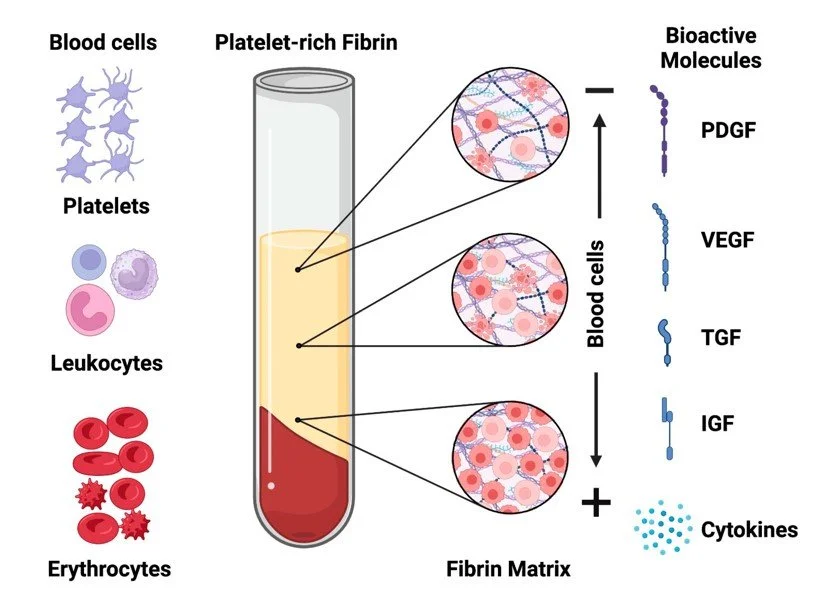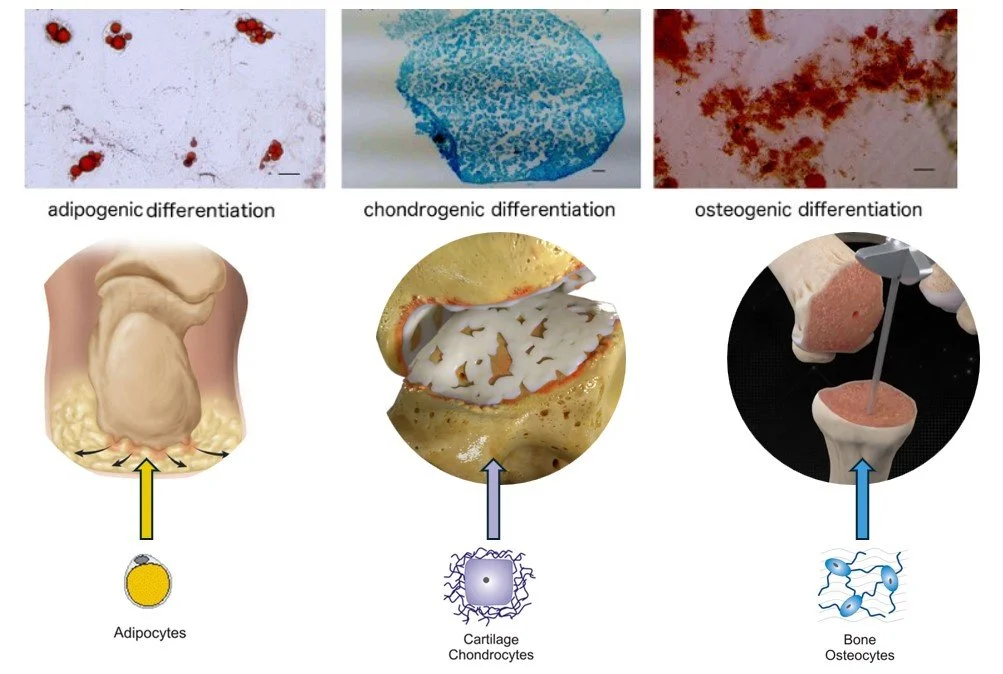The Power of Platelets
Platelets are more than clot formers—they are the architects of tissue healing and key modulators of the immune response.
Upon activation, they release a rich mix of growth factors, cytokines, and bioactive mediators that construct the provisional wound matrix, stimulate angiogenesis, and recruit regenerative cells.
At the same time, platelets modulate inflammation through immuno-thrombosis, pathogen trapping, and leukocyte signaling - ensuring that healing proceeds in balance with defense.
By harnessing these dual regenerative and immunomodulatory functions of platelet-rich plasma (PRP), providers can support recovery in sports medicine applications and optimize wound healing potential in limb salvage.
Mesenchymal Stem Cells - Maestros of the Microenvironment
Mesenchymal stem cells (MSCs) are multipotent progenitors capable of differentiating along osteogenic, chondrogenic, and adipogenic pathways, offering versatile applications in foot and ankle care.
When directed toward osteogenesis, bone marrow–derived MSCs harvested from the calcaneus/tibia can be concentrated and applied to sites of fusion, enhancing bone consolidation and union.
Through chondrogenesis, MSCs encapsulated within PRP-derived fibrin scaffolds can support cartilage matrix synthesis, providing a biologically active strategy for treating arthritic joints or focal chondral defects.
Along the adipogenic pathway, MSCs can be paired with adjunctive biologics such as hyaluronic acid to stimulate rejuvenation of the plantar fat pad, improving cushioning and reducing mechanical pain.
Collectively, these tri-lineage capabilities position MSC-based therapies as a regenerative cornerstone for addressing the structural, degenerative, and functional challenges unique to the foot and ankle
Regenerative Medicine Course Outline
4500 for up to 4 providers (750 for each additional provider)
-
Platelet & Mesenchymal Stem Cell Biophysiology
Cellular biology of platelets: activation mechanism, α-granule biogenesis, growth factor activity (VEGF, PDGF, TGF-β, IGF, etc.)
Hemostatic vs regenerative signaling pathways.
Cellular biology of Mesenchymal stem cell (MSC): niche dependence, immunomodulation, osteogenic vs chondrogenic vs adipogenic pathways
Mechanotransduction and microenvironmental cues in tendon, ligament, cartilage, and bone healing.
Evidence-based literature review: current foot & ankle PRP and BMAC outcomes.
-
Office-Based PRP Protocols for Tendinous, Ligamentous, and Joint Injuries
Clinical indications: Achilles tendinopathy, plantar fasciopathy, peroneal tendonitis, forefoot/midfoot arthritis.
Preparation protocols: leukocyte-rich vs leukocyte-poor PRP.
Injection techniques: ultrasound-guided vs palpation-guided approaches.
Pre-procedure hydration and patient optimization protocols
Post-procedure rehabilitation guidelines
Outcome tracking and registry participation.
-
PRP-Assisted Wound Care Protocols for Chronic Ulcers
Pathophysiology of Chronic Wounds
PRP application methods: topical gel, peri-wound injection, combination with skin substitutes (ADM/dHACMs)
Protocol standardization: number of applications, frequency, endpoints.
Clinical case series: PRP in neuropathic and venous ulcers.
Cost-benefit analysis for wound care practices.
-
Peripheral Venipuncture Training for PRP Collection
Vein anatomy (median cubital, cephalic, basilic)
Order of draw (CLSI guidelines)
Standard venipuncture step-by-step
Vein selection, tourniquet technique, aseptic preparation.
Needle selection and troubleshooting (small caliber veins, repeat sticks)
Hands-on workshop: practice on models, transition to live supervised draws.
Prevention and management of complications (hematoma, vasovagal syncope).
-
Overview of Insurance-Reimbursable CPT Codes vs Cash-Pay Offerings
CPT 0232T (PRP injection): non-covered services, cash-pay structuring
HCPCS G0465/G0460 (Autologous PRP for diabetic/non-diabetic wounds): solo-therapy vs in-combination with skin substitutes
CPTs 38220 (bone marrow aspiration): usage in elective foot & ankle procedures vs cash-pay structuring
Documentation requirements to reduce audit risk.
Ethical considerations in pricing and patient access.
-
Elective and Reconstructive Procedures
Indications: nonunions, arthrodesis augmentation, osteochondral lesions, osteoarthritis and joint salvage.
Aspiration technique: calcaneal body vs tibial harvest sites.
Delivery techniques: direct injection, fibrin encapsulation, graft soaking.
Integration with Minimally Invasive Internal fixation and other biologic adjuvants.
Surgical case reviews with intraoperative videos.
-
Centrifugation Parameters and Considerations
Principles of centrifugation: relative centrifugal force (RCF) vs RPM.
Comparative review: fixed-angle vs swing-bucket rotors.
Platelet yield optimization: single-spin vs double-spin protocols.
Variables affecting MSC yield: aspiration depth, volume, anticoagulant selection.
Commercial Device Comparison and Selection Criteria
-
FDA & Regulatory Oversight
FDA Section 361 HCT/P guidance: minimal manipulation and homologous use.
OHRP & IRB issues in investigational use.
CMS perspectives and coverage updates.
State medical board compliance and malpractice considerations.
Best practices: informed consent, patient registries, adverse event reporting.
-
Infection Control & Safety
OSHA standards, bloodborne pathogens, universal precautions
Hand hygiene and PPE
Sharps handling, disposal, and post-exposure protocol
-
Capstone Session
Case-based discussions: choosing PRP vs BMAC vs alternative biologics.
Mock patient consultations with coding/consent documentation.
OSCE-style skills check: venipuncture, ultrasound-guided injection, centrifuge setup.
Compliance audit simulation: chart review for regulatory readiness.



